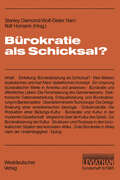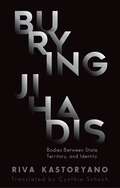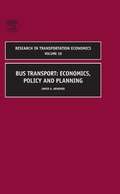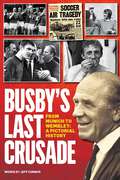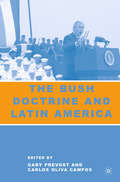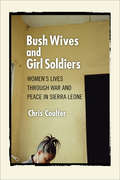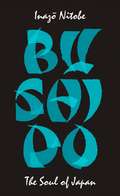- Table View
- List View
Bürokratietheorie: Einführung in eine Theorie der Verwaltung (Studienskripten zur Soziologie)
by Hans-Ulrich Derlien Doris Böhme Markus HeindlAusgehend von Max Webers Ausführungen möchte das Buch das für moderne Gesellschaften ubiquitäre Phänomen der "Bürokratie" theoretisch erfassen. Dabei werden vier Dimensionen herausgearbeitet und beschrieben: Bürokratietheorie als Gesellschaftstheorie, die Beziehungen zwischen Bürokratie und Politik, das Verhältnis von Individuum und Bürokratie sowie die Bürokratietheorie als Organisationstheorie. Das Buch schließt mit einem Blick auf das Thema der Entbürokratisierung.
Bürokratische Macht und demokratische Gesellschaft: Kontrolle der öffentlichen Verwaltung — ein internationaler Vergleich
by Ingeborg Eleonore SchäferThe Burr Conspiracy: Uncovering the Story of an Early American Crisis
by James E. Lewis Jr.A multifaceted portrait of the early American republic as seen through the lens of the Burr ConspiracyIn 1805 and 1806, Aaron Burr, former vice president of the newly formed American republic, traveled through the Trans-Appalachian West gathering support for a mysterious enterprise, for which he was arrested and tried for treason in 1807. This book explores the political and cultural forces that shaped how Americans made sense of the uncertain rumors and reports about Burr’s intentions and movements, and examines what the resulting crisis reveals about their anxieties concerning the new nation’s fragile union and uncertain republic.Burr was said to have enticed some people with plans to liberate Spanish Mexico, others with promises of land in the Orleans Territory, still others with talk of building a new empire beyond the Appalachian Mountains. The Burr Conspiracy was a cause célèbre of the early republic—with Burr cast as the chief villain of the Founding Fathers—even as the evidence against him was vague and conflicting. Rather than trying to discover the real intentions of Burr or his accusers—Thomas Jefferson foremost among them—James E. Lewis Jr. looks at how differing understandings of the Burr Conspiracy were shaped by everything from partisan politics and biased newspapers to notions of honor and gentility. He also traces the enduring legacy of the stories that were told and accepted during this moment of uncertainty. The Burr Conspiracy offers a panoramic and multifaceted portrait of the United States at a time when it was far from clear to its people how long it would last.
The Burr Conspiracy: Uncovering the Story of an Early American Crisis
by James E. Lewis Jr.A multifaceted portrait of the early American republic as seen through the lens of the Burr ConspiracyIn 1805 and 1806, Aaron Burr, former vice president of the newly formed American republic, traveled through the Trans-Appalachian West gathering support for a mysterious enterprise, for which he was arrested and tried for treason in 1807. This book explores the political and cultural forces that shaped how Americans made sense of the uncertain rumors and reports about Burr’s intentions and movements, and examines what the resulting crisis reveals about their anxieties concerning the new nation’s fragile union and uncertain republic.Burr was said to have enticed some people with plans to liberate Spanish Mexico, others with promises of land in the Orleans Territory, still others with talk of building a new empire beyond the Appalachian Mountains. The Burr Conspiracy was a cause célèbre of the early republic—with Burr cast as the chief villain of the Founding Fathers—even as the evidence against him was vague and conflicting. Rather than trying to discover the real intentions of Burr or his accusers—Thomas Jefferson foremost among them—James E. Lewis Jr. looks at how differing understandings of the Burr Conspiracy were shaped by everything from partisan politics and biased newspapers to notions of honor and gentility. He also traces the enduring legacy of the stories that were told and accepted during this moment of uncertainty. The Burr Conspiracy offers a panoramic and multifaceted portrait of the United States at a time when it was far from clear to its people how long it would last.
Burton Dassett Southend, Warwickshire: A Medieval Market Village (The Society for Medieval Archaeology Monographs)
by Nicholas Palmer Jonathan ParkhouseSouthend, one of five medieval settlements in Burton Dassett parish, Warwickshire, was the site of a market promoted by the manorial lord Bartholomew de Sudeley, with a charter being obtained in 1267. The settlement prospered, becoming known as Chipping Dassett, and approached urban status, but then declined throughout the 15th century. It was subjected to depopulation in 1497. The site survived as earthworks in pasture until construction of the M40 motorway necessitated the archaeological programme described here. The only building to survive was the 13th-century chapel of St James, reduced, along with an adjacent post-medieval priest’s house, to a cow-shed. Open area excavations at Southend investigated parts of ten medieval properties. There was some prehistoric and Romano-British activity, with evidence for woodland regeneration and subsequent clearance in the post-Roman period, despite the Feldon area being one often considered to have little in the way of tree-cover since the Roman period. The main period of occupation lasted from the mid-13th century to the late 15th century, reflecting the rise and decline of Chipping Dassett. Over 20 complete plans of houses and outbuildings were recorded, exhibiting a range of building techniques. The remains were well preserved, the surviving stratigraphy protected by demolition rubble. In most houses successive building phases were revealed and many internal features survived. A door jamb inscribed with the name of a tenant family ‘Gormand’ suggests a degree of functional literacy. One of the properties was recognised as a smithy during the excavation and a pioneering sampling and analysis of the ironworking evidence was carried out. The site was also sampled extensively for charred plant remains and, unusually for Warwickshire with its slightly acid soils, a large assemblage of animal bone was collected. Work on these provides direct evidence of medieval agricultural practice, to be compared with the local historical evidence. The large quantities of finds recovered, probably the largest assemblage from a medieval rural settlement in the West Midlands, enable the reconstruction of the material culture of a late medieval Warwickshire Feldon village. Although the excavated area lay away from the original settlement nucleus, the investigation revealed the mechanics of 13th-century market development with two separate stages of planned development apparent. After the mid-14th century the tenements show a complex pattern of decline leading up to the depopulation of 1497. The different properties followed varying development paths and the excavations chart a process of general community decline against a background of increasing individual prosperity. The evidence of material culture and settlement morphology, taken together, are relevant to the discussion about differentiation and similarities between urban and rural settlement. The medieval pottery has been crucial to the development of the Warwickshire type series. Identification of the pottery sources provides evidence for trade connections between the settlement and the wider market network, with the quantities of material from the Chilvers Coton kilns suggesting that manorial connections with North Warwickshire, where the Sudeley family also held land, were significant. The summary narrative and thematic discussions (focused upon material culture, spatial organisation, buildings and economy) in this volume are supplemented by detailed stratigraphic description and specialist reports available online through the Archaeology Data Service.
Burton Dassett Southend, Warwickshire: A Medieval Market Village (The Society for Medieval Archaeology Monographs)
by Nicholas Palmer Jonathan ParkhouseSouthend, one of five medieval settlements in Burton Dassett parish, Warwickshire, was the site of a market promoted by the manorial lord Bartholomew de Sudeley, with a charter being obtained in 1267. The settlement prospered, becoming known as Chipping Dassett, and approached urban status, but then declined throughout the 15th century. It was subjected to depopulation in 1497. The site survived as earthworks in pasture until construction of the M40 motorway necessitated the archaeological programme described here. The only building to survive was the 13th-century chapel of St James, reduced, along with an adjacent post-medieval priest’s house, to a cow-shed. Open area excavations at Southend investigated parts of ten medieval properties. There was some prehistoric and Romano-British activity, with evidence for woodland regeneration and subsequent clearance in the post-Roman period, despite the Feldon area being one often considered to have little in the way of tree-cover since the Roman period. The main period of occupation lasted from the mid-13th century to the late 15th century, reflecting the rise and decline of Chipping Dassett. Over 20 complete plans of houses and outbuildings were recorded, exhibiting a range of building techniques. The remains were well preserved, the surviving stratigraphy protected by demolition rubble. In most houses successive building phases were revealed and many internal features survived. A door jamb inscribed with the name of a tenant family ‘Gormand’ suggests a degree of functional literacy. One of the properties was recognised as a smithy during the excavation and a pioneering sampling and analysis of the ironworking evidence was carried out. The site was also sampled extensively for charred plant remains and, unusually for Warwickshire with its slightly acid soils, a large assemblage of animal bone was collected. Work on these provides direct evidence of medieval agricultural practice, to be compared with the local historical evidence. The large quantities of finds recovered, probably the largest assemblage from a medieval rural settlement in the West Midlands, enable the reconstruction of the material culture of a late medieval Warwickshire Feldon village. Although the excavated area lay away from the original settlement nucleus, the investigation revealed the mechanics of 13th-century market development with two separate stages of planned development apparent. After the mid-14th century the tenements show a complex pattern of decline leading up to the depopulation of 1497. The different properties followed varying development paths and the excavations chart a process of general community decline against a background of increasing individual prosperity. The evidence of material culture and settlement morphology, taken together, are relevant to the discussion about differentiation and similarities between urban and rural settlement. The medieval pottery has been crucial to the development of the Warwickshire type series. Identification of the pottery sources provides evidence for trade connections between the settlement and the wider market network, with the quantities of material from the Chilvers Coton kilns suggesting that manorial connections with North Warwickshire, where the Sudeley family also held land, were significant. The summary narrative and thematic discussions (focused upon material culture, spatial organisation, buildings and economy) in this volume are supplemented by detailed stratigraphic description and specialist reports available online through the Archaeology Data Service.
Bury Me Standing: The Gypsies and their Journey (Vintage Departures Ser.)
by Isabel FonsecaGypsies have always intrigued and fascinated - partly because of their mysterious origins, and partly because of the romance of nomadism. But because they resist assimilation, having survived as a distinct people for over a thousand years, they have also been the victims of other people's nationalism and xenophobia. In this fascinating and timely study, Fonseca focuses particularly on the gypsies in Eastern Europe (an estimated 6 million), and their future as a distinct race within a nationalist Europe. While researching the book, Fonseca learned Romany and stayed with the gypsies, becoming deeply involved with their lives, and befriending several gypsy kings. The result is a clolourful and frank book, filled with enthusiasm and curiosity, without lapsing into piety or romanticism.
Bury My Heart in a Free Land: Black Women Intellectuals in Modern U.S. History
by Hettie V. WilliamsCovering the history and contributions of black women intellectuals from the late 19th century to the present, this book highlights individuals who are often overlooked in the study of the American intellectual tradition.This edited volume of essays on black women intellectuals in modern U.S. history illuminates the relevance of these women in the development of U.S. society and culture. The collection traces the development of black women's voices from the late 19th century to the present day. Covering both well-known and lesser-known individuals, Bury My Heart in a Free Land gives voice to the passion and clarity of thought of black women intellectuals on various arenas in American life—from the social sciences, history, and literature to politics, education, religion, and art.The essays address a broad range of outstanding black women that include preachers, abolitionists, writers, civil rights activists, and artists. A section entitled "Black Women Intellectuals in the New Negro Era" highlights black women intellectuals such as Jessie Redmon Fauset and Elizabeth Catlett and offers new insights on black women who have been significantly overlooked in American intellectual history.
Bury My Heart in a Free Land: Black Women Intellectuals in Modern U.S. History
by Hettie V. WilliamsCovering the history and contributions of black women intellectuals from the late 19th century to the present, this book highlights individuals who are often overlooked in the study of the American intellectual tradition.This edited volume of essays on black women intellectuals in modern U.S. history illuminates the relevance of these women in the development of U.S. society and culture. The collection traces the development of black women's voices from the late 19th century to the present day. Covering both well-known and lesser-known individuals, Bury My Heart in a Free Land gives voice to the passion and clarity of thought of black women intellectuals on various arenas in American life—from the social sciences, history, and literature to politics, education, religion, and art.The essays address a broad range of outstanding black women that include preachers, abolitionists, writers, civil rights activists, and artists. A section entitled "Black Women Intellectuals in the New Negro Era" highlights black women intellectuals such as Jessie Redmon Fauset and Elizabeth Catlett and offers new insights on black women who have been significantly overlooked in American intellectual history.
Bury St. Edmunds: Medieval Art, Architecture, Archaeology and Economy
by Antonia GransdenThis book focuses on art, palaeography, bindings and the monastic library. It is based on lectures given at the Association's Annual Conference, the 20th in the present series, which was held at Bury St Edmunds, from 16 to 20 April 1994: three specially commissioned articles are also included.
Bury St. Edmunds: Medieval Art, Architecture, Archaeology and Economy
by Antonia GransdenThis book focuses on art, palaeography, bindings and the monastic library. It is based on lectures given at the Association's Annual Conference, the 20th in the present series, which was held at Bury St Edmunds, from 16 to 20 April 1994: three specially commissioned articles are also included.
Bury the Chains: The British Struggle to Abolish Slavery
by Adam HochschildEighteenth-century Britain was the world’s leading centre for the slave trade. Profits soared and fortunes were made, but in 1788 things began to change. Bury The Chains tells the remarkable story of the men who sought to end slavery and brought the issue to the heart of British political life. ‘Hochschild's marvellous book is a timely reminder of what a small group of determined people, with right on their side, can achieve. Carefully researched and elegantly written, with a pacy narrative that ranges from the coffee houses of London to the back-breaking sugar plantations of the West Indies, it charts the unlikely success of the first international human rights movement' Saul David, Literary Review 'Hochschild is such a gifted researcher and story-teller that he never fails to hold the reader's attention. . . For all its terrible theme, Hochschild's book is not in the least depressing, because it is suffused with admiration for the courage and enlightenment of the men and women who crusaded against this evil, and finally prevailed' Max Hastings, Sunday Telegraph 'Thought-provoking, absorbing and well-written' Brendan Simms, Sunday Times 'Stirring and unforgettable' Economist
Burying Jihadis: Bodies Between State, Territory, and Identity
by Riva KastoryanoWhat should states do with the bodies of suicide bombers and other jihadists who die while perpetrating terrorist attacks? This original and unsettling book explores the host of ethical and political questions raised by this dilemma, from (non-)legitimization of the 'enemy' and their cause to the non-territorial identity of individuals who identified in life with a global community of believers. Because states do not recognize suicide bombers as enemy combatants, governments must decide individually what to do with their remains. Riva Kastoryano offers a window onto this challenging predicament through the responses of the American, Spanish, British and French governments after the Al-Qaeda suicide attacks in New York, Madrid and London, and Islamic State's attacks on Paris in 2015. Interviewing officials, religious and local leaders and jihadists' families, both in their countries of origin and in the target nations, she has traced the terrorists' travel history, discovering unexpected connections between their itineraries and the handling of their burials. This fascinating book reveals how states' approaches to a seemingly practical issue are closely shaped by territory, culture, globalization and identity.
Burying Jihadis: Bodies Between State, Territory, and Identity
by Riva KastoryanoWhat should states do with the bodies of suicide bombers and other jihadists who die while perpetrating terrorist attacks? This original and unsettling book explores the host of ethical and political questions raised by this dilemma, from (non-)legitimization of the 'enemy' and their cause to the non-territorial identity of individuals who identified in life with a global community of believers. Because states do not recognize suicide bombers as enemy combatants, governments must decide individually what to do with their remains. Riva Kastoryano offers a window onto this challenging predicament through the responses of the American, Spanish, British and French governments after the Al-Qaeda suicide attacks in New York, Madrid and London, and Islamic State's attacks on Paris in 2015. Interviewing officials, religious and local leaders and jihadists' families, both in their countries of origin and in the target nations, she has traced the terrorists' travel history, discovering unexpected connections between their itineraries and the handling of their burials. This fascinating book reveals how states' approaches to a seemingly practical issue are closely shaped by territory, culture, globalization and identity.
The Bus Stop Killer: Milly Dowler, Her Murder and the Full Story of the Sadistic Serial Killer Levi Bellfield
by Geoffrey WansellGeoffrey Wansell's The Bus Stop Killer is chilling portrait of a notorious serial killer.On 23 Jun 2011 the convicted double-murderer Levi Bellfield was found guilty of the murder of 13-year-old school girl Milly Dowler.Milly disappeared on her way home from school in Walton-on-Thames, Surrey in 2002. Six months later her body was discovered many miles away. A massive police investigation, the largest manhunt in Surrey's history, got nowhere. Only when nightclub bouncer and bare-knuckle boxer Levi Bellfield was arrested for the murder of another young woman did it become clear to police that they had a serial killer on their hands.This is the full story of the murders, the victims and the pain-staking nine-year investigation and trial by police and prosecutors. It tells of Bellfield's terrifying, controlling personality - a man who went from charming to monstrous in the blink of an eye - and his depraved stalking of young women.The Bus Stop Killer is Geoffrey Wansell's terrifying portrait of the only man in modern British legal history to be given two whole-life sentences.Geoffrey Wansell has been acknowledged as one of Britain's leading authorities on serial killers. He was short-listed for the Whitbread Prize (now the Costa Book Award) for his biography of Terence Rattigan, and was appointed by the Official Solicitor to the Supreme Court to write the biography of Gloucester-based serial killer Frederick West. He lives in London, and is an award-winning freelance journalist who works principally for the Daily Mail.http://www.geoffreywansell.com/
Bus Transport: Economics, Policy and Planning (ISSN #Volume 18)
by David A. HensherThe bus is the most patronised of all land–based public passenger mode but is seen as a somewhat unglamorous means of supporting mobility and accessibility, in contrast to rail – heavy and light, yet offers so much to the travelling public as well as offering attractive sustainability opportunities. This book reflects the author’s perspective on issues of importance to the preservation and health of the bus sector. The twenty one chapters cover the themes of institutional reform, performance measurement and monitoring, service quality, costing and pricing of services including commercial and non-commercial contracts, travel choice and demand, integrated bus-based systems, and public transport policy, especially challenges in growing patronage.
Busby's Last Crusade: From Munich to Wembley: A Pictorial History
by Jeff ConnorThe Munich air disaster was one of the most tragic incidents to ever occur in British sport. The crash at Munich airport in 1958 claimed the lives of twenty-three people, including eight of Manchester United’s first team, and injured many more, including United’s iconic manager, Matt Busby.From Munich to Wembley charts the aftermath of the tragedy, from the poignant scenes of mourning in Manchester to the team’s return to the field as Busby began the heart-wrenching task of rebuilding the club.Jeff Connor tracks the remarkable story of United’s rise from the ashes of Munich. It is a journey that captures the imagination and epitomises the soul of this golden age of British football as we see the likes of George Best, Jack Charlton and Denis Law stamp their mark on the game, and we witness the team become the first side from England to be crowned European champions.
Bush Base, Forest Farm: Culture, Environment, and Development
by Elisabeth Croll David ParkinTaking a unique anthropological apprach, Bush Base: Forest Farm explores the management of resources in third would development programmes. The contributors, all distinguished anthropologists with practical experience of development projects, focus on the role of human cultural imagination in the use of environmental resources. They challenge the traditional sharp distinction between human settlement and natual environment (farm or camp, forest or bush), and argue that development programmes should place at their centre an appreciation of people's cosmologies and cultural understandings.
Bush Base, Forest Farm: Culture, Environment, and Development
by Elisabeth Croll David ParkinTaking a unique anthropological apprach, Bush Base: Forest Farm explores the management of resources in third would development programmes. The contributors, all distinguished anthropologists with practical experience of development projects, focus on the role of human cultural imagination in the use of environmental resources. They challenge the traditional sharp distinction between human settlement and natual environment (farm or camp, forest or bush), and argue that development programmes should place at their centre an appreciation of people's cosmologies and cultural understandings.
Bush Bound: Young Men and Rural Permanence in Migrant West Africa
by Paolo GaibazziWhereas most studies of migration focus on movement, this book examines the experience of staying put. It looks at young men living in a Soninke-speaking village in Gambia who, although eager to travel abroad for money and experience, settle as farmers, heads of families, businessmen, civic activists, or, alternatively, as unemployed, demoted youth. Those who stay do so not only because of financial and legal limitations, but also because of pressures to maintain family and social bases in the Gambia valley. ‘Stayers’ thus enable migrants to migrate, while ensuring the activities and values attached to rural life are passed on to the future generations.
The Bush Doctrine and Latin America
by G. Prevost C. CamposThis volume focuses on the contemporary political, economic and security affairs of the Western Hemisphere. Following a decade of focus on economic matters around the Free Trade Area of the Americas (FTAA), the authors argue that the Bush Doctrine formed in the wake of 9/11 has resulted in a renewed U.S. concentration on security matters.
Bush Wives and Girl Soldiers: Women's Lives through War and Peace in Sierra Leone
by Chris CoulterDuring the war in Sierra Leone (1991–2002), members of various rebel movements kidnapped thousands of girls and women, some of whom came to take an active part in the armed conflict alongside the rebels. In a stunning look at the life of women in wartime, Chris Coulter draws on interviews with more than a hundred women to bring us inside the rebel camps in Sierra Leone. When these girls and women returned to their home villages after the cessation of hostilities, their families and peers viewed them with skepticism and fear, while humanitarian organizations saw them primarily as victims. Neither view was particularly helpful in helping them resume normal lives after the war. Offering lessons for policymakers, practitioners, and activists, Coulter shows how prevailing notions of gender, both in home communities and among NGO workers, led, for instance, to women who had taken part in armed conflict being bypassed in the demilitarization and demobilization processes carried out by the international community in the wake of the war. Many of these women found it extremely difficult to return to their families, and, without institutional support, some were forced to turn to prostitution to eke out a living. Coulter weaves several themes through the work, including the nature of gender roles in war, livelihood options in war and peace, and how war and postwar experiences affect social and kinship relations.
Bushcraft und Survival für Dummies (Für Dummies)
by Martin EngewichtWald, Wildnis, unberührte Natur - immer mehr Menschen reizt diese Vorstellung. Allein und auf sich selbst gestellt draußen überleben, sich nur von dem ernähren, was die Natur bietet, und Werkzeuge und Unterkunft aus dem bauen, was Sie im Wald finden: Martin Engewicht zeigt Ihnen, wie es geht. In diesem Buch erfahren Sie, was Sie beim Bushcrafting immer im Rucksack haben sollten, welche Pflanzen als Nahrung dienen können und wie Sie auch in Notfällen einen kühlen Kopf bewahren. Sie werden sehen: Mit der richtigen Vorbereitung werden auch Sie sich bald in der Natur heimisch fühlen.
Bushido: An Exposition Of Japanese Thought (Penguin Great Ideas)
by Inazo Nitobe'What Japan was she owed to the samurai. They were not only the flower of the nation, but its root as well.'Inazo Nitobe's book, the most influential ever written on Bushido, or the samurai Way of the Warrior, argues that the philosophy of Bushido is the true key to understanding 'the soul of Japan'.One of twenty new books in the bestselling Penguin Great Ideas series. This new selection showcases a diverse list of thinkers who have helped shape our world today, from anarchists to stoics, feminists to prophets, satirists to Zen Buddhists.
